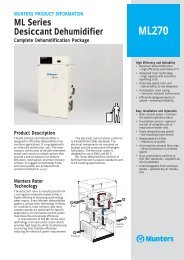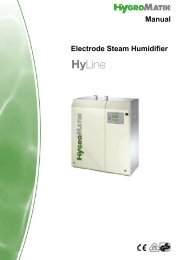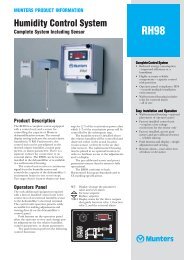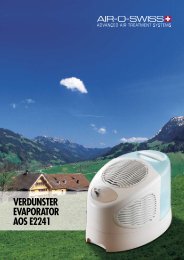Electrode Steam Humidifier Manual
Electrode Steam Humidifier Manual
Electrode Steam Humidifier Manual
Create successful ePaper yourself
Turn your PDF publications into a flip-book with our unique Google optimized e-Paper software.
The concentration of dissolved salts increases over time, which<br />
can lead to a rise in the conductivity of the water. If this continues,<br />
conductivity may increase until a short circuit occurs. This<br />
could damage the unit, but in any case would significantly<br />
reduce the life span of the electrodes.<br />
For this reason, regular, periodic blow-downs of some of the<br />
concentrated water are very important. Following this procedure<br />
as recommended provides stable cylinder water conductivity as<br />
well as minimal water loss for the expected service life of the cylinder.<br />
Water blow-down is performed by a blow-down pump (32). The<br />
functioning of the blow-down pump is continuously monitored<br />
during operation. If the pump is damaged, the steam humidifier<br />
shuts down.<br />
With normal water quality, the blow-down loss rate is between<br />
7% and 15% of the amount of steam produced. The steam cylinder<br />
requires complete drainage every 3-8 days, regardless of<br />
the water quality.<br />
Mineral deposits (H) settle in the open area below the electrodes<br />
and are removed through periodic maintenance. The blow-down<br />
pump itself has wide openings and can flush out smaller pieces<br />
of mineral deposit. This extends the service life of the unit and<br />
reduces the required maintenance interval.<br />
During blow-downs, water flows from the pump into the drainage<br />
system.<br />
A sensor electrode (10) monitors the maximum water capacity<br />
of the cylinder. When the water level reaches the sensor electrode,<br />
the water supply is interrupted. This can occur when the<br />
water has low conductivity or when the electrodes are worn out.<br />
In the case of low water conductivity, however, this state usually<br />
lasts only a short time. The built-in control and the large area<br />
electrodes combine to produce a rapid rise in conductivity by<br />
increasing the concentration of the water.<br />
The steam cylinder consists of a top (16) and lower (19) part<br />
joined with a cylinder flange. The seal between the cylinder and<br />
cylinder base (37), as well as between the top and lower part of<br />
the cylinder, is maintained using an o-ring (35).<br />
Page 13








